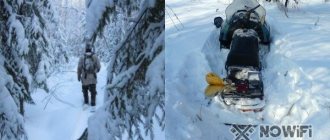Updated: 07/18/2021
The rules of mountaineering and tourism activities do not allow solo movement in the mountains. However, by chance, a person may find himself alone with nature. Whether a tourist gets lost or lags behind the group, in the absence of means of communication and unfamiliarity with the area, one can wander among deserted mountains or plains for quite a long time. How to survive in the mountains, especially if you are lost? But even in extreme conditions and in such a situation, you can provide a cozy overnight stay, fast and safe movement and food, and find your way home. Much depends on knowledge, experience and training.
Orientation is the first condition for survival in the mountains
To survive in the mountains, the first step is to determine the cardinal directions and direction. Know where to go without a compass, even if the battery of your smartphone or navigator is dead. What to do if you get lost in the mountains? Once out into the open (exposed peak, rock, tall tree), look at the slopes. In the conditions of Turkmenistan, on the northern slopes there are usually more trees, primarily Turkmen maple - kerkava and shrubs, than on the southern slopes, they are less dried out by the sun. In winter, there is no more melted snow on the northern slopes. On a sunny day, having a watch, you can even more accurately determine the sides of the horizon. For example, on March 21, the sun rises from the east and at 13 o’clock it will be at the zenith - in the south.
When moving, the safest and shortest way to the plain is along the axis of the ridge, its crest. To survive in the mountains, it is not recommended to go down gorges due to possible cliffs and elevation changes. And the path through winding gorges is usually not the shortest. In the dense bush you can take advantage of wildlife trails.
Determining time by the constellation Ursa Major
The earth rotates and the heavenly bodies move across the sky. However, the North Star in the constellation Ursa Major is stationary; all constellations revolve around it. This star “hangs” exactly above the north pole of our planet, which means it is always located strictly in the north.
Determining time by the constellation Ursa Major
If on a clear night you mentally imagine a dial with the North Star in the center and draw an “hour hand” from it to the two outer stars of the “bucket” of the Big Dipper, then you can set the time using the celestial clock. Let's say that the hand shows 6.5 conventional hours. Let's determine the month number from the beginning of the year to this day (every 3 days we count as 1/10 of the month). For example, for September 12 you need to take the number 9.4. We add the resulting number with the sidereal clock reading and multiply by two: (6.5 + 9.4) x 2 =31.8. This number must be subtracted from the constant number 55.3. 55.3 – 31.8 = 23.5. 23 h 30 min. or 11.30 p.m. If after subtraction the number turns out to be greater than 24, then subtract the number 24 from it.
Determining the sides of the horizon by the Sun
To do this, place the clock in a horizontal plane, pointing the hour hand towards the Sun. The angle between the hour hand and the direction towards number 1 is divided in half. Then the bisector of this angle will indicate approximately the north-south direction. This method in southern latitudes, where the Sun is high in summer, gives approximate results.
Determining the direction by the Sun and the clock: a – before noon, b – after noon.
SELECTION OF ACCOMMODATION
If night finds you in the mountains, it is better to choose a place to spend the night that is protected from the wind, warmed up during the day on the southern slopes, this will make it easier to survive in the mountains. Cold air accumulates in low areas at night due to temperature inversions. How can we wait until morning safely? You should avoid places along hollows where rockfalls or avalanches can occur; they can be identified visually - damaged tree trunks, chaotically lying stones on a pebble bed, traces of impacts on boulders with stone chips. Where avalanches occur, twisted trees grow there. Fresh avalanches - the snow is chaotically piled up, the avalanche strip is higher, shrub vegetation is noticeably shaved off. Remember this if you intend to survive in the mountains and not suffocate under the snow and stone mass!
If possible, place the tents on micro-elevations so that in case of rain the litter does not flood. Do not spend the night in gorges along river banks, and especially on islands, due to the dangers of mudflows. If you have to camp in such places, determine the maximum level of water rise during previous floods and place the tent above it - it’s safer.
Survive in the mountains in any weather
Rain and thunderstorm
Cirrus clouds high in the sky are harbingers of bad weather. They are located at an altitude of 9000 m and higher, visible at a distance of 100-200 km. These clouds are 400-500 km ahead of precipitation and pass 12-16 hours before rain or snow. If a cold front approaches, cumulus clouds precede it. They are located at an altitude of 5000 m and above. Mostly rain clouds are stratus clouds, they are found below cumulus clouds.
Swallows and swifts darting up and down, spiders tearing part of the threads of their web warn of windy weather. Also harbingers of the wind are smoke from a fire tending to the ground in the evening, a crimson halo around the moon that does not disappear for a long time. A dog curling up into a ball or a cat covering its nose with its paws warn of cold weather.
When a lot of cumulus-stratus rain clouds have accumulated in the sky, there is stuffiness and calmness - all these are signs of a possible thunderstorm; at such a time you should not spend the night on the crests of ridges and under tall trees. Lightning is a strong electrical discharge between a cloud and the ground, or even between two clouds. In a few microseconds, an electric current flows from 5 to 110 kiloamperes. The length of the lightning channel is on average about 5 km, sometimes up to 14 km.
High lightning danger zones
When a thunderstorm approaches, it is worth descending from the hills and ridges raised above the area. The height of the ledge under which the climber is located should exceed 5-10 times human height, and you should not move away from the ledge to a distance greater than the height of this rock. A lightning strike can ruin your chances of surviving in the mountains. But if, for example, the cliff is 15 meters high, then at a distance of up to 15 meters from its base there is no fear of a lightning strike.
As the thundercloud approaches the protruding rocks and the potential difference increases, a characteristic faint crackling and rustling can be heard in the air, and a bluish glow can be seen in the darkness. This is a serious warning of danger.
Temperature
The human body is able to function within a narrow range of body temperature - from 30 to 42 degrees Celsius. And the comfortable range is even narrower, being around 36°C. Cold and heat can make it difficult to survive in the mountains. Therefore, our body spends so much energy on maintaining a constant body temperature, but sometimes it is no longer able to cope with unfavorable environmental factors and begins to lose ground.
During the hot season, follow the recommendations: light-colored clothing, it is advisable not to leave exposed areas of the body in the sun. The head and neck should be covered with a white scarf - burnous, a headdress proven by generations of Arab nomads. In summer, it is advisable to travel early in the morning and in the evening; it is better to rest when the sun is at its zenith, until about 16:00. Food increases thirst. The less water you have, the less you try to eat. It is better to take food with you with a predominant carbohydrate content. It is better to drink water more often, but in very small portions. With a single consumption of one liter of water, 16-58% of it is excreted through the kidneys and with sweat. But if you drink the same liter of water in 85 ml portions, then losses through sweating will be reduced to 5-17%.
When the air temperature exceeds 33°C, the body actively sweats to avoid overheating. Every gram of sweat evaporates carries away 581 calories of heat. At an air temperature of 38°C, water loss through sweating is 700 grams per hour or 16 liters per day. During hard physical work in extreme heat, a person produces up to 30 grams of sweat per minute or 18 liters in 10 hours.
Dehydration of the body is accompanied by disturbances in physiological functions. With water loss of 4-6% of body weight, severe thirst, discomfort in the body, faster pulse, drowsiness and lethargy appear. Hoarseness of voice is a sign of dehydration of 6–8%, headache appears, dizziness, unsteady gait. It is difficult to speak, the swollen tongue seems to stick to the roof of the mouth. Further loss of water is accompanied by difficulty swallowing, hallucinations, and tinnitus. A person falls into an unconscious state and dies from irreversible disorders of the central nervous system and blood circulation. At air temperatures above 30°C, a loss of 15% of the body’s initial body weight can be fatal. If the air is cool, then a water loss of 25% is considered fatal.
If you start to freeze, remember that lost heat is not restored in a timely manner and the temperature of body parts decreases unevenly. The extremities are cooled first. The back of the head and neck of a person are especially sensitive to a decrease in body temperature. If you have to overcome water obstacles, remember - the thermal conductivity of water is 25 times higher than that of air. Once in it, the body begins to lose heat much faster. A person at a water temperature of 26°C loses consciousness after 12 hours due to heat loss. At a water temperature of 10°C, loss of consciousness occurs after 30-60 minutes, and death occurs after 1-2 hours. In water at zero temperature, a person without protective clothing loses consciousness after 15 minutes, and he faces death within half an hour.
Moneybox of knowledge
Survival in the mountains depends entirely on where the accident occurred or people got lost, the location of the mountain range (hemisphere, continent, distance from populated areas) and vertical zonation. In the highlands, people in extreme situations will face the same problems as in the polar tundra. However, in the forest belt the possibilities of survival increase significantly.
Mountains
And yet, the greatest danger for a person who finds himself in an extreme situation in a mountainous area is represented by: sparsely populated or uninhabited mountain areas, where not only special gear and equipment is required, but also certain skills in moving in the mountains. Moreover, the most extreme conditions of existence in the mountains arise at altitudes above 3000 m, since there the number of plants and representatives of the animal world decreases significantly, and with a further increase in altitude it disappears completely;
climatic features of the highlands associated with low temperatures and their sharp drops, hurricane winds, the presence of snow cover and glaciers, icefalls, serious thunderstorm danger; a specific mountainous terrain with a vertical structure, the associated high avalanche danger, mountain falls, landslides, rockfalls and the widespread distribution of screes, forming cones and trails of small and large stones on the slopes. Often they are so steep that the movement of stones can occur for no apparent reason;
Sudden and heavy rains lead to a sharp rise in water levels in mountain streams and rivers, making crossing them dangerous and sometimes impossible. This is aggravated by the low water temperature in the rivers and the strength of the water flow. And frequent fogs make orientation difficult; lack of fuel, shortage, and at high altitudes, complete absence of food (edible plants, insects, small and large animals); oxygen deficiency, caused by rarefied air at altitudes above 2000 m, has a significant impact on psychological stability, attention and performance. At altitudes above 4500 m above sea level, lack of oxygen can lead to even greater complications - pulmonary edema and respiratory paralysis.
Therefore, the general strategy for survival in high mountains comes down to descending as quickly as possible to safe heights (below 2000 m above sea level).
Features of movement in mountainous areas
Walking in the mountains at random in order to shorten the path is extremely unacceptable, as this can lead to serious irreparable consequences, for example, reaching a steep scree with vertical ledges, impassable rocky areas, large glacial crevasses, deep canyons with steep walls, etc. Big The surface of mountain slopes is important for movement in the mountains: rocky, with or without vegetation, the steepness of the slope, the presence of snow and ice, scree and rocky areas. It may turn out that a person or group of people who find themselves in the mountains as a result of a car or aircraft accident (plane, helicopter, glider, balloon) are completely unfamiliar with the technology of movement in the mountains. It is pointless to give comprehensive recommendations on the pages of this book, since it is impossible to acquire technical skills by reading the rules - some practice is needed, but here is some advice on what to do in a given situation and how best to choose the direction of movement, its rhythm and at the same time observe basic safety rules, yes.
In the mountains you should know and remember that:
the steeper the area, the slower you need to move along it; the weight of the load being carried should not exceed one third of the body weight, otherwise the load increases sharply, the general fatigue of the whole body increases faster, which leads to overexertion and loss of attention;
depending on the steepness of the slope, the weight of the load being carried and physical fitness, it is necessary to make short stops every 25-45 minutes of movement; use rest as efficiently as possible, relaxing all the muscles of the body, and if you have to rest while standing, then transfer the center of gravity of the body to the elbows and buttocks so that the muscles of the legs and back can rest; If you feel unwell, have severe shortness of breath, or have an increased heart rate above 120 beats/min, you should stop for a few minutes and catch your breath. Resume movement only after the pulse normalizes;
a steep slope covered with grass, on which your feet slide, is overcome in a zigzag (serpentine) or herringbone pattern; when overcoming a steep snowy slope, knock out steps, compacting them well;
in order not to lose balance on a steep slope, the body weight is transferred, resting on the entire foot;
when moving along the ridge, you must stay below the windward side, especially if the slope is covered with snow, since in this case the snow here is denser;
It is advisable to bypass snow bridges over cracks if possible. If this is not possible, then cross such a snow bridge only one by one with mandatory insurance. If you are alone, then it is better not to take risks and look for a workaround;
overcome an avalanche-dangerous slope quickly (if it is not possible to choose another path), silently, trying to follow the trail, so that a trench does not form, but with a large interval necessary to overcome the avalanche-dangerous area. Signs of avalanche danger include weather conditions, slope steepness, and time of day. But the most favorable conditions for the formation of wet avalanches arise from heavy and heavy snowfalls (especially in spring), after which warm and clear weather sets in. Under the sun's rays, the snow melts and on a steep slope (most often grassy) it can slide off like a huge board of snow for no apparent reason. But with heavy snowfall, after 3-4 days dry avalanches occur, formed by a large accumulation of dry, freshly fallen snow; If it is possible to choose a route in an avalanche zone, it is preferable to move along a slope overgrown with bushes or trees, with bedrock outcrops, and to avoid steep narrow valleys and gorges. It is best to overcome avalanche-prone slopes early in the morning;
It is best to descend into the valley along a gentle ridge, without going onto steep slopes;
if there is a need to go down the scree, then under no circumstances should you go straight down, but diagonally along a serpentine path, placing your foot on the entire foot, having first tested the stone for stability; move along the scree at intervals and so as not to be on top of each other due to the possibility of dropping a stone on the head of the person below;
it is necessary to take into account that a steep scree can begin to move from a loud scream, or careless movement along it, or from thrown stones;
in case of a scree collapse, it is necessary to outline a possible shelter in advance; if the scree is not completely visible or it is very steep, then moving down it is dangerous - it may end in a cliff; some supposed mountain “paths” are not such, since they are formed due to the sliding of the soil and do not lead anywhere, but they can also be trampled by mountain goats and lead to steep cliffs;
movement along a narrow canyon is dangerous - you may end up on steep sections that cannot be bypassed due to the steepness of the slopes; when entering a wide mountain valley, gorge with a stream or river, you need to move downstream with preliminary reconnaissance of the path for the possibility of moving along the shore (for overhanging rocks and waterfalls);
if it is necessary to ford mountain rivers, this should be done in the early morning hours, since the water level at these hours is minimal and rises sharply only by noon due to the melting of snow and ice under the rays of the sun;
When crossing a mountain stream, the crossing point should be chosen in places of greatest flood, where the current is calmest. But we must take into account that the bottom with fine sand is dangerous - the sand is abundantly saturated with water and can suck a person in the same way as a bog in a swamp. The absence of breakers and whirlpools indicates that the bottom is flat, but in this place it can be quite deep; Having found a suitable place for crossing, the river is crossed diagonally, upstream and facing it. The leg is moved without pulling it out of the water, smoothly and without jerking, so as not to lose balance; After each day's trek there should be a good rest, which is only possible by organizing a normal camp, protected from wind, avalanches and rockfalls. Life support in the mountains
Catering in the event of an extreme situation and the need for long-term autonomous existence in mountainous areas has its own characteristics. They are connected, first of all, with what continent, in what mountains and at what altitude you are.
In addition, it should be remembered that many people already at an altitude of about 2000 m experience a deterioration or even complete loss of appetite. Many products generally cause rejection and even disgust, and when consumed they are not absorbed by the body. These symptoms can only intensify with altitude. As a rule, there are no problems with water, with the exception of high mountain deserts. But water can still be found there too. Water in the mountains can be found at the foot of the plateau - where the bright green vegetation stands out sharply. Often water, condensing from the air after a cool night, accumulates in small depressions on stones and depressions at the base of cliffs. There is water in karst caves and in the beds of dry streams.
Sometimes in a dry riverbed on a hot day in the evening water appears from a melted snowfield or glacier. You can also use ice and snow to melt water on the fire. However, it should be remembered that snow and glacial water do not contain salts and do not quench thirst well. And if there is snow, then due to the high carbon dioxide content in it, it not only does not quench, but further increases thirst and greatly dries out the oral cavity. Procurement of food, as in other natural areas, occurs through hunting small rodents, birds, and various animals.
Each natural zone has its own edible plants, but there are also those that are found everywhere. They are shown on the colored tab. Difficulties may arise with fuel for cooking and heating in the treeless highlands. Moreover, in the zone of eternal snow, this problem is practically insoluble, and the only way to avoid it is to descend as soon as possible to heights no higher than 2500 m. But where there is at least some vegetation, it, mixed with dry animal droppings, can be used for cooking.
Mountain weather forecast
Signs of inclement weather: a crown has formed near the sun or moon and cirrostratus clouds have appeared; cirrus clouds appear and move quickly; the clouds gradually rise upward; with good visibility and clear, clean air in the evening, torn clouds appear that cling to high peaks; the wind blows from the mountains to the valleys during the day, and vice versa at night; stuffy night and lack of dew - there will be a thunderstorm in a few hours; electrical discharges at the sharp ends of metal objects in the form of faintly glowing lights (St. Elmo's lights) at night - a thunderstorm is approaching; the appearance of clouds during the day in the mountains means frost. Signs of improving weather include cloudy haze; cumulus clouds disappear in the evening; in the evening fog appears in the valleys and dew falls; in the evening, when the sky is clear and the temperature drops, the wind subsides in the valleys; In the evening the clouds gradually descend into the valley and disappear in the morning.
Read about this topic on the website:
Features of survival in the jungle Survival in the taiga Survival in arctic conditions Features of movement in uninhabited areas How to find the right road in an unfamiliar area Preparing for the transition in search of salvation Providing life and personal hygiene in extreme situations
Survival in the mountains: 7 unfavorable factors
The only thing better than mountains are mountains that no one has ever been to.
V.S. Vysotsky
Mountains are an extremely difficult test of human strength, skills and perseverance. Even prepared expeditions can return back with losses, let alone people who stray from their group and were forced to survive in the mountains alone for some time. They don't have much of a chance, to be honest.
However, a tough survivalist cannot be broken even by such difficulties, especially if he knows everything he needs about survival in the mountains and knows how to withstand the main adverse factors. Yes, we are not specifically considering a situation where a person has to survive in the mountains without equipment, as was the case in the Andes in 1972. So it is assumed that you have clothes and basic equipment suitable for mountain survival. So.
The content of the article
Temperature
As practice shows, for every 100 meters of vertical rise, the temperature drops by 1 degree. So it's damn cold in the mountains. And in combination with variable humidity and strong winds, this is especially unpleasant. Therefore, the main problem that a climber who lags behind his comrades faces is not to freeze to death. And for this you need to additionally insulate. As experienced climbers advise, additional attention should be paid to the areas of the legs, neck, lower back and hands. The latter are especially important because they freeze very easily, and this completely deprives a person of the ability to do something. So, without additionally insulated gloves, you can’t go to the mountains. All other places can be additionally insulated with banal fabric windings.
Sun
There is a very angry sun in the mountains. It shines brightly, but doesn't provide any warmth. And light, reflected from snow and smooth stones, can cause “snow blindness” when exposed to the eyes for a long time. Therefore, an important item for survival in the mountains is polarized sunglasses. But that's not all. The sun barely warms, but actively showers everything around with strong ultraviolet radiation, which does not have time to dissipate in the rarefied air. This results in burns to exposed areas of the skin – nose, lower lip, chin. This is exactly the situation when a tactical beard can seriously help. But if you don’t have time to grow a beard, then a banal fabric mask will do.
Fog
It is extremely difficult to move over rough terrain when you can see no further than 20 meters. And this situation is not uncommon in the mountains and foothills. You only have two options. The first, safest one is to stop, quickly set up a camp and wait out the bad weather. But if the fog persists for several days (and this is also possible), then this is not the best solution. And the second is to move carefully, from visible landmark to visible landmark, leave signs behind you and try not to lose orientation. The method is extremely risky, since in the mountains and in normal weather you can easily stumble and fall down.
Rain
The higher you are, the less chance you have of getting caught in the rain. And that’s fortunate, because getting wet to the skin in the mountains is another test of survival skills . What exactly is the matter? Wet stones slip and become covered with ice. Wet clothes provide less warmth and also become covered with ice crystals. Frozen fingers are unable to cope with the simplest actions. There is only one way out - find shelter, make a fire and try to warm up and dry out. If it doesn’t work, try to dry your clothes at least in the wind.
Glaciers
The higher you are in the mountains, the greater the chances of getting onto a glacier. There is only one possible danger here - hidden cracks and faults, dusted with snow and covered with ice. If you fall into such a crevice, you’ll never get back out. Therefore, when moving along a glacier, you should always probe the surface in front of you with a long pole or stick.
Rockfalls
Even one pebble falling from a great height can cause a lot of trouble. And in the mountains, rockfalls occur regularly, especially in the morning, about two hours after sunrise, when the rocky slopes begin to warm up unevenly, and the stone blocks begin to split and crack. Therefore, an important factor for survival in the mountains is a protective helmet. It’s better to get a mild concussion than an open TBI (traumatic brain injury). The noise of rolling stones usually warns of trouble. As soon as you hear it, hide under a canopy or cornice, and if there are none, pull your head into your neck and cover it with a backpack.
Avalanches
God forbid you get caught in an avalanche in the mountains - this is the worst thing that can happen there. When a huge mass of slightly melted ice, snow and stones falls from a great height and rushes down, gaining speed and size, it is almost impossible to survive. But there are some things you can do to increase your chances of survival.
- Try to stay on the surface of the avalanche. This is difficult, but theoretically possible, since the moving mass of snow and ice allows for floating movements.
- Try to avoid getting snow into your respiratory tract.
- As soon as the avalanche has stopped, use a stream of saliva to determine where is up and where is down and immediately begin to dig out, if possible.
Let's be honest, a single person has practically no chance. Digging out a mass of compressed snow is difficult even with an infantry shovel, let alone with battered hands. But if you are lucky and the snow layer does not exceed a meter, there is a chance, albeit small. The main thing is not to panic, breathe slowly and evenly, and avoid convulsive activity. Because all the fuss increases the release of carbon dioxide, which is deadly in a confined space.
As you can see, survival in the mountains is an extremely difficult task that will require maximum effort, good physical and theoretical preparation, as well as great luck.
And it’s better not to subject yourself to such a test, especially alone. Mountains are exactly the case when it is much easier to survive in a team. Your comrade will insure you, help you, and, if anything happens, try to dig you out from under the avalanche.









